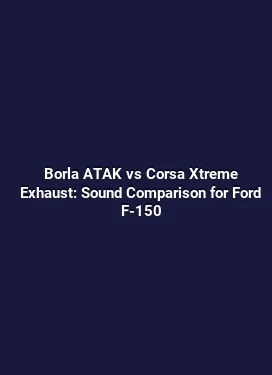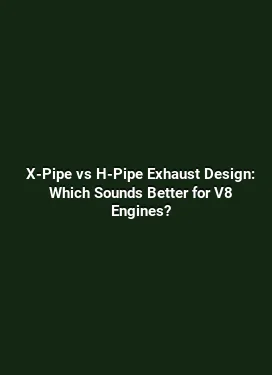Exhaust Wrap vs Ceramic Coating: A Comprehensive Heat Management Comparison for Exhaust Systems
Heat management is a critical aspect of automotive exhaust performance. Both exhaust wrap and ceramic coating are commonly considered solutions to control under-hood temperatures, protect components, and potentially improve performance. This article delves into the material science, real-world results, installation considerations, maintenance, and practical scenarios where each solution shines. By examining thermal properties, durability, and cost considerations, readers can make an informed choice tailored to their build, driving style, and long-term goals.
Understanding the Basics: What Each Solution Offers

Exhaust wrap is typically a fibrous material wrapped around exhaust pipes, headers, or downpipes to reduce radiant heat transfer. Ceramic coating, on the other hand, is a hard, sprayed-on or brushed coating applied to the exterior of exhaust components to form a protective ceramic layer that reflects and insulates heat. Both approaches aim to lower surface temperatures and manage heat flow, but they do so through different mechanisms and with distinct secondary effects.
When evaluating heat management strategies, it is essential to consider how heat transfer occurs in exhaust systems. Conduction transfers heat through solid materials, convection dissipates heat into ambient air, and radiation is the direct transfer of heat energy from hot surfaces. Exhaust wrap reduces radiant heat emission by trapping heat inside the wrapped section, while ceramic coatings act as a barrier that lowers emissivity and improves insulation efficiency. These differences translate into varied results under different operating conditions and environmental factors.
Thermal Performance: What to Expect from Wraps and Coatings
Thermal performance hinges on several material properties. For wraps, key attributes include insulation value (often measured by temperature reduction on surrounding components), durability under thermal cycling, and ease of installation. High-quality wraps may lower under-hood temperatures by noticeable margins and reduce heat soak into nearby intake components, reducing potential power-robbing heat spillage in turbocharged or high-output setups.
Ceramic coatings bring a different set of advantages. The coating forms a hard ceramic layer that reflects radiant heat and minimizes heat absorption by the metal substrate. This can result in lower surface temperatures on pipes and headers, improved exhaust gas velocity due to temperature gradients, and enhanced engine bay comfort for occupants in street-driven vehicles. In some configurations, ceramic coatings also provide corrosion resistance and assist with thermal stability during sustained high-temperature operation.
Key comparative metrics to track

To assess performance, consider metrics such as surface temperature reductions at critical points (manifold, downpipes, near the firewall), heat soak duration after engine shutoff, and any measurable changes in under-hood air temperatures. Real-world tests often show wraps providing more immediate radiant heat reduction on adjacent components, while ceramic coatings tend to deliver consistent, long-term insulation with the added benefit of a hard-wearing exterior surface that resists flaking and corrosion when properly applied.
Durability and Longevity: Lifespan under Real World Conditions
Durability plays a central role in deciding between wrap and coating. Exhaust wraps are typically built from fiberglass or basalt fibers woven into a flexible tape or sheet. They can be highly effective, but poor installation or exposure to prolonged high heat with moisture can lead to fiber unraveling, moisture retention, or fiber shift, which reduces effectiveness and may require replacement. Maintenance involves inspecting for fraying, removing loose fibers, and ensuring no sharp edges abrade nearby components.
Ceramic coatings are designed to be more resilient when properly cured and applied. A premium ceramic coating can withstand high exhaust temperatures, resist chemical exposure from road salts and fuels, and maintain its thermal properties over thousands of miles. The coating’s integrity depends on surface preparation, cure time, and compatibility with the substrate. A chipped or poorly adhered coating can undermine performance and require spot repairs or reapplication.
Service life considerations
In typical street-driven environments, ceramic coatings tend to offer a longer service life with less maintenance if properly applied and protected from physical damage. Wraps may need periodic restringing or re-wrapping after a few seasons, particularly in harsh climates or areas with frequent off-road exposure. High-quality heat shields, mounting hardware, and careful routing reduce the risk of damage to either solution and extend service life.
Practical Applications: When to Choose Wraps, When to Choose Coatings
Choosing between wrap and coating is rarely a one-size-fits-all decision. Several practical scenarios help guide the selection:
- Turbocharged or high-heat engines in performance builds: Wraps can deliver rapid radiant heat reduction near sensitive components, potentially helping with intake temperature management. Ceramic coatings provide sustained insulation along exhaust runners and headers, which can support more consistent exhaust gas temperatures and improved back-pressure management in some setups.
- Off-road or dusty environments: Wraps may be less forgiving if exposed to abrasive debris and moisture, which can degrade fibers over time. Ceramic coatings offer a robust exterior that resists corrosion and road grime, making them attractive for rugged usage.
- Daily drivers seeking minimal maintenance: Ceramic coatings typically require less ongoing maintenance, as they resist corrosion and can be easier to clean. Wraps may require more attention to inspect for wear and replace when degraded.
- Cost sensitivity and flexibility: Initial cost for wraps is often lower, with the possibility of customization and repair by the user. Coatings usually demand professional application for best results and longer-term durability, which can increase upfront costs but reduce maintenance needs.
In engines with sensitive catalytic converters or O2 sensors placed near exhaust components, careful routing and the choice of material can influence heat exposure of these sensors. Both options should be vetted against manufacturer guidelines and local regulations for aftermarket modifications.
Installation: Best Practices for Maximum Effectiveness
Proper installation is central to achieving the promised benefits. For wraps, follow a systematic approach: clean the surface, ensure dryness, and apply the wrap with appropriate tension to avoid gaps. Avoid overlapping too tightly, which can trap moisture and promote corrosion in certain conditions. Use high-temperature sealants where recommended, and secure the wrap with stainless steel ties or clamps designed for high-heat environments. After installation, a heat cycle helps the wrap settle into place and reduces memory against sharp bends.
Ceramic coating requires meticulous surface preparation: removing old coatings or contaminants, ensuring a clean metal substrate, and performing a multi-step degreasing and etching process. The coating is then applied in multiple thin layers with controlled humidity and temperature, followed by a cure period. Proper curing is essential to achieve full adhesion and the protective properties the coating promises. At installation, avoid contamination of the coating surface with water or dust until the cure is complete, as contaminants can compromise adhesion and finish quality.
Maintenance tips for sustained performance
Maintenance for wraps includes periodic inspection for fraying, signs of moisture retention, and re-tightening or re-wrapping as needed. Cleaning should be gentle to avoid fibers breaking loose. For ceramic coatings, routine cleaning with non-abrasive cleaners preserves the ceramic layer. Inspect for chips or flaking after impact or curb contact, and address any damage promptly to prevent corrosion or heat transfer anomalies. Both solutions benefit from keeping nearby sensors, wiring looms, and clamps free from excessive heat exposure or vibration that can loosen fasteners over time.
Performance Integration with Modern Engine Bay Design
As engine bay layouts evolve with advanced turbocharging, direct injection, and hybrid powertrains, heat management strategies must align with overall thermal design. Effective heat control supports sensor accuracy, reduces heat soak that can impact fuel economy, and stabilizes intake air temperatures, all of which influence performance perception and drivability. Wraps and coatings contribute to a broader thermal strategy by containing radiant heat, reducing thermal gradients, and supporting longevity of nearby components such as ignition coils, wiring harnesses, and intake manifolds. The choice between wrap and coating can be influenced by how the rest of the exhaust system and engine bay are designed, including heat shields, turbo placement, and accessory routing.
Long-term reliability and emerging trends
New manufacturing processes and material blends continue to refine both wraps and coatings. Advances include improved abrasion resistance, higher temperature capabilities, and reduced moisture susceptibility. Additionally, user education around installation techniques and maintenance has grown, helping enthusiasts achieve better outcomes. In terms of trends, there is increasing emphasis on whole-system thermal management—integrating wraps or coatings with heat shields, thermal barriers for intercoolers, and strategic insulation around electrical components to minimize heat-induced failures.
Cost, Availability, and Practical Considerations
Cost is a practical driver in decision-making. Exhaust wraps vary in price based on material quality, thickness, and length, with higher-end options offering better moisture stability and temperature resistance. Ceramic coatings have higher upfront costs due to professional application requirements, the need for surface preparation, and curing time, but may deliver longer intervals between maintenance and reapplication. Availability spans through aftermarket retailers, professional coating services, and DIY kits, each with varying quality control, warranties, and application guidance.
Practical considerations also include warranty implications, the potential impact on exhaust gas temperatures, and the effect on nearby components like heat shields and rubber or plastic lines that could be exposed to elevated heat if insulation is compromised. A holistic assessment—evaluating how heat travels through the entire exhaust path and into the engine bay—helps determine whether a wrap, a coating, or a combination offers the best balance of performance, protection, and cost.
Concluding Thoughts: A Systems-Oriented Approach to Heat Management
Successful heat management in exhaust systems requires a thoughtful, systems-oriented approach. While wraps excel at rapid radiant heat reduction and may be a cost-effective solution for specific high-heat zones, ceramic coatings offer durable thermal barriers with low maintenance when applied correctly. For many enthusiasts, a hybrid approach—selective wrapping of particularly vulnerable sections paired with ceramic coating on critical heat-exposed components—can deliver the best overall performance, durability, and value. Regardless of the chosen method, adherence to proper installation techniques, regular inspection, and alignment with the vehicle’s overall thermal strategy are essential to achieve consistent, real-world benefits.






